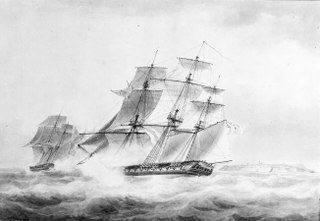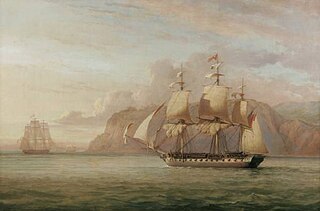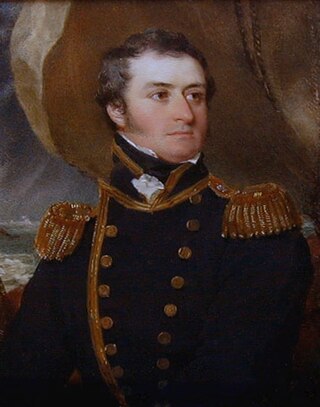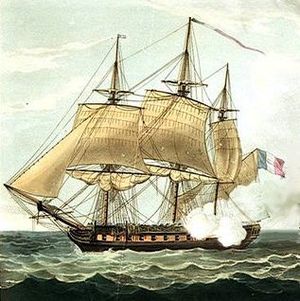
HMS Thames was a 32-gun Richmond-class fifth-rate frigate of the Royal Navy built by Henry Adams and launched at Bucklers Hard in 1758. She served in several wars, including for some four years in French service after her capture. She was recaptured in 1796 and was broken up in 1803.

Révolutionnaire, was a 40-gun Seine-class frigate of the French Navy, launched in May 1794. The British captured her in October 1794 and she went on to serve with the Royal Navy until she was broken up in 1822. During this service Revolutionnaire took part in numerous actions, including three for which the Admiralty would in 1847 award clasps to the Naval General Service Medal, and captured several privateers and merchant vessels.
HMS Daring was a 12-gun gun-brig of the Archer class of the British Royal Navy. She was launched in 1804 and served in the Channel and North Sea, capturing a number of merchant vessels. In 1813 she was serving on the West Africa Station when her crew had to scuttle her to prevent her capture.

HMS Phoenix was a 36-gun Perseverance-class fifth-rate frigate of the Royal Navy. The shipbuilder George Parsons built her at Bursledon and launched her on 15 July 1783. She served in the French Revolutionary and Napoleonic Wars and was instrumental in the events leading up to the battle of Trafalgar. Phoenix was involved in several single-ship actions, the most notable occurring on 10 August 1805 when she captured the French frigate Didon, which was more heavily armed than her. She was wrecked, without loss of life, off Smyrna in 1816.

Proserpine was a 38-gun Hébé-class frigate of the French Navy launched in 1785 that HMS Dryad captured on 13 June 1796. The Admiralty commissioned Proserpine into the Royal Navy as the fifth rate, HMS Amelia. She spent 20 years in the Royal Navy, participating in numerous actions in the French Revolutionary and Napoleonic Wars, capturing a number of prizes, and serving on anti-smuggling and anti-slavery patrols. Her most notable action was her intense and bloody, but inconclusive, fight in 1813 with the French frigate Aréthuse. Amelia was broken up in December 1816.

The Battle of Tory Island was a naval action of the French Revolutionary Wars, fought on 12 October 1798 between French and British squadrons off the northwest coast of County Donegal, then in the Kingdom of Ireland. The last action of the Irish Rebellion of 1798, the Battle of Tory Island ended the final attempt by the French Navy to land substantial numbers of soldiers in Ireland during the war.

Rear Admiral Frederick Paul Irby was a British Royal Navy officer and Deputy Lord Lieutenant of Norfolk.

Aréthuse was a French frigate, launched in 1757 during the Seven Years' War. She was captured by the Royal Navy in 1759 and became the fifth-rate HMS Arethusa. She remained in Royal Navy service for twenty years until she was wrecked after being badly damaged in battle.
HMS Niemen was a Royal Navy 38-gun fifth-rate frigate. She began her career as the Niémen, a 44-gun French Navy Armide-class frigate, designed by Pierre Rolland. She was only in French service for a few months when in 1809 she encountered some British frigates. The British captured her and she continued in British service as Niemen. In British service she cruised in the Atlantic and North American waters, taking numerous small American prizes, some privateers but mostly merchantmen. She was broken up in 1815, at the end of the Napoleonic Wars and the War of 1812.

Furieuse was a 38-gun frigate of the French Navy. The Royal Navy captured her in 1809 and took her into service as the fifth rate HMS Furieuse. She spent most of her British career in the Mediterranean Sea, though towards the end of the War of 1812 she served briefly on the North American station. She was laid up in 1815 and sold for breaking up in 1816.

Pierre-François-Henri-Étienne Bouvet de Maisonneuve was a French Navy officer and privateer.

Aréthuse was a 46-gun frigate of the French Navy. She served during the Napoleonic Wars, taking part in a major single-ship action. Much later the vessel took part in the conquest of Algeria, and ended her days as a coal depot in Brest, France.

HMS Favourite was a 16-gun Cormorant-class sloop of the Royal Navy, launched in 1794 at Rotherhithe. The French captured her in 1806 and renamed her Favorite. However, the British recaptured her in 1807 and renamed her HMS Goree. She became a prison ship in 1810 and was broken up in Bermuda in 1817.
HMS Alcmene was a 32-gun Alcmene-class fifth rate of the Royal Navy. This frigate served during the French Revolutionary and Napoleonic Wars under the command of several notable officers. Alcmene was active in several theatres of the war, spending most of her time cruising in search of enemy vessels or privateers, and escorting convoys. She fought at the Battle of Copenhagen in 1801 and served in the blockade of the French coasts during the later Napoleonic Wars until she was wrecked on the French coast in 1809.

Aréthuse, launched in April 1798, was the name-ship of the eponymous Aréthuse-class corvettes of the French Navy. Excellent captured her in 1799. The Royal Navy took her into service under the name HMS Raven. She was wrecked in 1804.
HMS Nemesis was a 28-gun Enterprise-class sixth-rate frigate of the Royal Navy. The French captured her in 1795 at Smyrna, but in 1796 a squadron led by Barfleur brought her out of the neutral port of Tunis. Throughout her career she served under a number of commanders who would go on to have distinguished careers. She was converted to a troopship in 1812 and was sold in 1814.

HMS Venus was the name ship of the 36-gun Venus-class fifth-rate frigates of the Royal Navy. She was launched in 1758 and served for more than half a century until 1809. She was reduced from 36 to 32 guns in 1792. She was sold in 1822.

During the night of 7 February 1813, two evenly matched frigates from the French Navy and the British Royal Navy, Aréthuse and HMS Amelia, engaged in a battle in the Atlantic Ocean at the Îles de Los, off Guinea. The action lasted four hours, causing significant damage and casualties to both opponents, and resulted in a stalemate. The two ships parted and returned to their respective ports of call, with both sides claiming victory.
Louis-François Ollivier was a French Navy officer.

The action of 24 March 1811 was a minor naval engagement of the Napoleonic Wars, fought as part of the Royal Navy blockade of the French English Channel ports. By 1811, Royal Navy control of the French coast was so entrenched that French ships were unable to travel safely even in French territorial waters. In late 1810, French frigates Elisa and Amazone sailed from Le Havre to join with a larger squadron at Cherbourg-en-Cotentin, but were intercepted by a British frigate squadron and forced to shelter at Saint-Vaast-la-Hougue. There they came under sustained attack and Elisa was destroyed, Amazone successfully slipping back to Le Havre under cover of darkness. To prevent Amazone from escaping once more, the British blockade squadron was reinforced.















